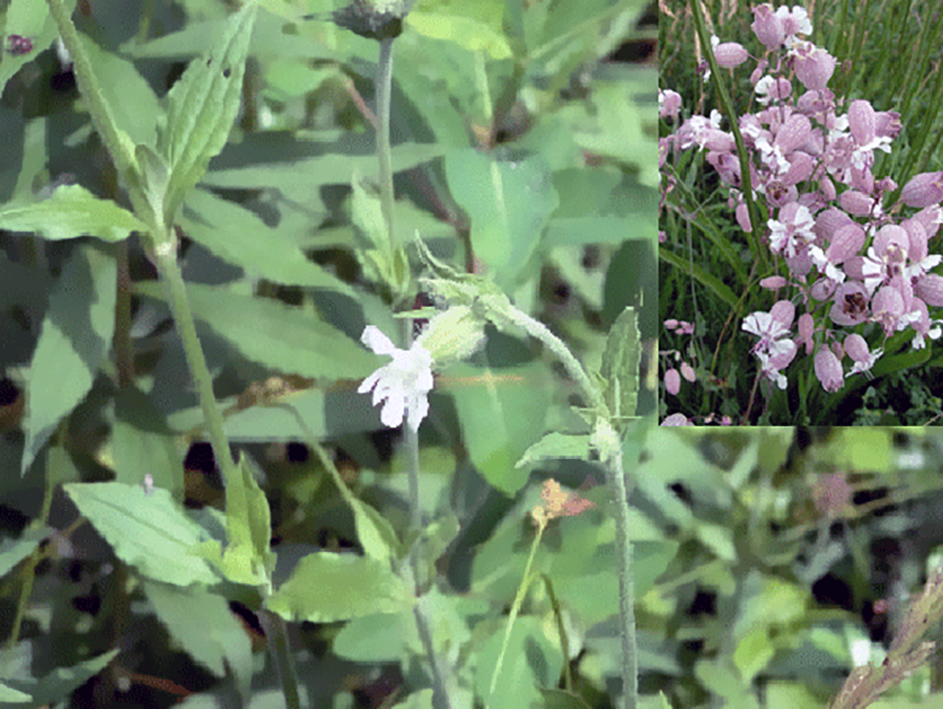 The image, above, shows the full bladder campion plant
The image, above, shows the full bladder campion plant(Silene vulgaris) with immature flowers is shown, left.
Inset are the mature flowers of the plant..
| Common Name: Bladder Campion |
| Scientific Name: Silene vulgaris |
| Other Names: |
| Family: Caryophyllaceae |
| Range: Most of Europe, including Britain, to N. Africa and temperate Asia. |
Physical Characteristics Silene vulgaris is a hardy Perennial plant, growing to 60cm (2 ft) in height. It is hardy to zone 6 and is not frost tender. The plant flowers from June to August and the seeds ripen from July to September. The flowers are dioecious (individual flowers are either male or female, but only one sex is seen on a given plant) and are pollinated by bees and lepidoptera. The plant is not self-fertile.
Silene vulgaris is a hardy Perennial plant, growing to 60cm (2 ft) in height. It is hardy to zone 6 and is not frost tender. The plant flowers from June to August and the seeds ripen from July to September. The flowers are dioecious (individual flowers are either male or female, but only one sex is seen on a given plant) and are pollinated by bees and lepidoptera. The plant is not self-fertile.
|
| Edible Parts: Leaves |
|
|
|
|
Welcome to the summary page for FabulousFusionFood's Wild Food guide to Bladder Campion along with all the Bladder Campion containing recipes presented on this site, with 5 recipes in total.
This is a continuation of an entire series of pages that will, I hope, allow my visitors to better navigate this site. As well as displaying recipes by name, country and region of origin I am now planning a whole series of pages where recipes can be located by meal type and main ingredient. This page gives a listing of all the Cornish recipes added to this site.
These recipes, all contain Bladder Campion as a major wild food ingredient.
[2]. Huxley, A. The New RHS Dictionary of Gardening. 1992
[3]. Tanaka, T. Tanaka's Cyclopaedia of Edible Plants of the World.
[4]. Lim T.K. Edible Medicinal And Non-Medicinal Plants, Vols 1–8.
[5]. Thomas, G. S. Perennial Garden Plants
[6]. Milner, E. Trees of Britain and Ireland
[7]. Rose, F. & O'Reilly, C. The Wild Flower Key (Revised Edition) – How to identify wild plants, trees and shrubs in Britain and Ireland
[8]. Streeter, D. & Garrard, I. The Wild Flowers of the British Isles
[9]. Clapham, A.R.; Tutin, T.G. & Moore, D.M. Flora of the British Isles
[10]. Phillips, R. Mushrooms
[10]. Phillips, R. Mushrooms
[11]. Jordan, P. & Wheeler, S. The Complete Book of Mushrooms: An Illustrated Encyclopedia of Edible Mushrooms
[12]. Bunker, F.; Brodie, J.A.; Maggs, C.A. & Bunker, A. Seaweeds of Britain and Ireland.
[13]. Facciola, S. Cornucopia — A Source Book of Edible Plants
This is a continuation of an entire series of pages that will, I hope, allow my visitors to better navigate this site. As well as displaying recipes by name, country and region of origin I am now planning a whole series of pages where recipes can be located by meal type and main ingredient. This page gives a listing of all the Cornish recipes added to this site.
These recipes, all contain Bladder Campion as a major wild food ingredient.
References:
[1]. David Evans Notes from field observations, tastings and cookery experiments.[2]. Huxley, A. The New RHS Dictionary of Gardening. 1992
[3]. Tanaka, T. Tanaka's Cyclopaedia of Edible Plants of the World.
[4]. Lim T.K. Edible Medicinal And Non-Medicinal Plants, Vols 1–8.
[5]. Thomas, G. S. Perennial Garden Plants
[6]. Milner, E. Trees of Britain and Ireland
[7]. Rose, F. & O'Reilly, C. The Wild Flower Key (Revised Edition) – How to identify wild plants, trees and shrubs in Britain and Ireland
[8]. Streeter, D. & Garrard, I. The Wild Flowers of the British Isles
[9]. Clapham, A.R.; Tutin, T.G. & Moore, D.M. Flora of the British Isles
[10]. Phillips, R. Mushrooms
[10]. Phillips, R. Mushrooms
[11]. Jordan, P. & Wheeler, S. The Complete Book of Mushrooms: An Illustrated Encyclopedia of Edible Mushrooms
[12]. Bunker, F.; Brodie, J.A.; Maggs, C.A. & Bunker, A. Seaweeds of Britain and Ireland.
[13]. Facciola, S. Cornucopia — A Source Book of Edible Plants
The alphabetical list of all Bladder Campion recipes on this site follows, (limited to 100 recipes per page). There are 5 recipes in total:
Page 1 of 1
| A Messe of Greens Origin: Britain | Potaje de Garbanzo e Collejas (Chickpea Stew with Bladder Campion) Origin: Spain | Tagliatelle con gli Stridoli (Tagliatelle with Bladder Campion) Origin: San Marino |
| Gazpacho Vuido Origin: Spain | Tagliatelle con gli Stridoli (Tagliatelle with Bladder Campion) Origin: Italy |
Page 1 of 1